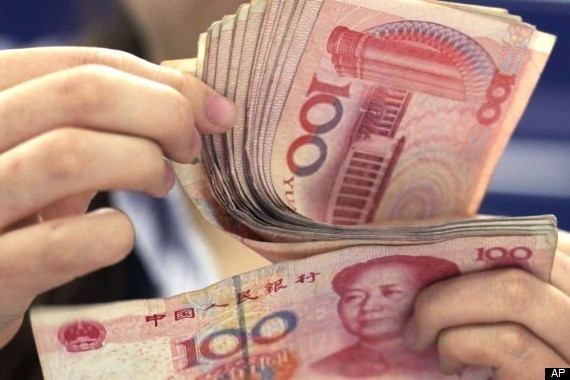China’s Central Bank has again cut the guiding rate for the national currency, the yuan, a day after Tuesday’s record 1.9% devaluation.
The move sent fresh shockwaves through Asian markets, but the bank has sought to calm fears, saying it was not the start of a sustained depreciation.
This is now the biggest two-day lowering of the yuan’s rate against the dollar in more than two decades.
The commerce ministry said the lower rate would boost struggling exports.
Figures released at the weekend showed Chinese exports fell more than 8% in July, adding to concerns the world’s second largest economy is heading for a slowdown.
There were further signs of weakness on Wednesday, when figures showed industrial production in July rose 6% from the previous year. The rise was smaller than expected and was also below the 6.8% increase seen in June.
Fixed asset investment, a measure of state spending on infrastructure, expanded 11.2% for the first half of the year, also below estimates and at its lowest since December 2000.
However, the action on the yuan has sparked fears of a global and destabilising “currency war”. There has been criticism from the US, where markets fell sharply overnight.
Read more: Asian stocks down on lower yuan
Karishma Vaswani: Not why, but why now?
One-off?
On Wednesday, China’s central bank fixed the “official midpoint” for the yuan down 1.6% to 6.3306 against the dollar.
The midpoint is a guiding rate, from which trade can rise or fall 2% during the day.
Until Tuesday, that rate had been determined solely by the People’s Bank of China (PBOC) itself. But the rate will now be based on overnight global market developments and how the currency finished the previous trading day.
The bank, which had called Tuesday’s 1.9% cut a “one-off” adjustment, sought to reassure financial markets on Wednesday.
“Looking at the international and domestic economic situation, currently there is no basis for a sustained depreciation trend for the yuan,” it said in a statement.
Analysis: Karishma Vaswani, Asia Business Correspondent
But the question we should be asking isn’t how much did China’s devalue its currency by – but why now?
China’s been under international pressure to allow its currency to be driven by market forces as opposed to by the government for years. The US has been its biggest critic – saying that Beijing keeps the currency artificially low to help boost exports.
So in theory, China says it is doing what the US and the international community wants. According to the language of the Chinese central bank – China will now allow the yuan’s value to be more flexible.
Backing from IMF
The International Monetary Fund said the move to make the rate more market-based “appears a welcome step”.
“Greater exchange rate flexibility is important for China as it strives to give market-forces a decisive role in the economy and is rapidly integrating into global financial markets,” the international lender said in a statement.
“We believe that China can, and should, aim to achieve an effectively floating exchange rate system within two to three years.”
The IMF added, though, that the decision would not affects its considerations of Beijing’s hopes for the yuan to be added to the “special drawing rights” (SDR) reserve currencies.
These are currencies which IMF members can use to make payments between themselves or to the Fund.
China has long been lobbying to have the yuan included alongside the dollar, euro, yen and the British pound.








